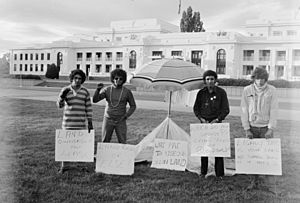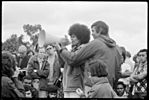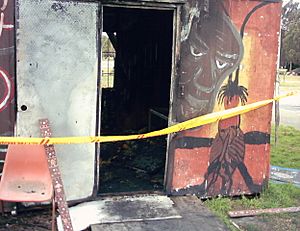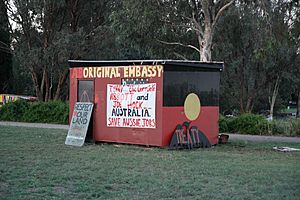Aboriginal Tent Embassy facts for kids
Quick facts for kids Aboriginal Tent Embassy |
|||
|---|---|---|---|
| Indigenous land rights in Australia Part of History of Indigenous Australians |
|||
|
From top: Billy Craigie, Bert Williams, Ghillar Michael Anderson and Tony Coorey, first day of the Aboriginal Tent Embassy, January 1972; Police question protesters, January 1972, Bobbi Sykes and Gordon Briscoe, July 1972; January 2015; Australia Day 2010
|
|||
| Date | 26/27 January 1972 | ||
| Location |
Canberra, Australia
35°18′04″S 149°07′48″E / 35.30111°S 149.13000°E |
||
| Caused by | Dispossession of Indigenous Australians | ||
| Goals | Land rights, self-determination and reassertion of Indigenous sovereignty | ||
| Methods | Nonviolent resistance, civil disobedience, peaceful protest | ||
| Status | Ongoing | ||
| Parties to the civil conflict | |||
|
|||
| Lead figures | |||
|
|||
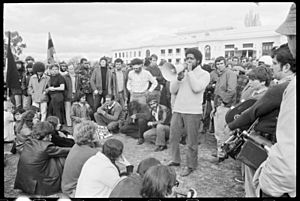
The Aboriginal Tent Embassy is a permanent protest site in Canberra, Australia. It was set up to fight for the political rights of Aboriginal and Torres Strait Islander people. It started on 26 January 1972, which is Australia Day for some, but known as Invasion Day by many Aboriginal people.
The Embassy celebrated its 50th anniversary in 2022. It is now the longest continuous protest for Indigenous land rights in the world. It began with just a beach umbrella. Today, it includes signs and tents. Since 1992, it has been on the lawn opposite Old Parliament House. The Australian Government does not see it as an official embassy.
The Embassy has been a key place for protests and support. It champions the recognition of Indigenous land rights in Australia, justice for Aboriginal deaths in custody, and self-determination. It also supports Indigenous sovereignty, meaning Aboriginal people having control over their own affairs.
Contents
Why the Embassy Started
Chicka Dixon, an Aboriginal leader, said the idea for the Embassy came from Jack Patten in 1946. Patten was a co-founder of the Aborigines Progressive Association. He wanted an Aboriginal mission station in front of Parliament House. This would show the world the struggles of Australia's First Peoples.
In 1967, Australians voted in a special referendum. This vote changed the Australian Constitution. It allowed Aboriginal people to be counted in the Australian census. It also allowed the government to make laws for them. However, many young Aboriginal people felt things were not changing fast enough.
On 26 January 1972, Prime Minister William McMahon announced a new policy. This policy was about how Aboriginal people could use land. His government did not recognise Aboriginal land rights. Instead, they offered 50-year leases. These leases were conditional on Aboriginal people using the land for "economic and social" purposes. The government kept the rights to minerals and forestry. This new policy angered many Indigenous people.
1972: The Beginning

On 26 January 1972, four Aboriginal men arrived in Canberra from Sydney. They were Michael Anderson, Billy Craigie, Tony Coorey, and Bertie Williams. They set up a beach umbrella on the lawn in front of Parliament House. This was the start of the Aboriginal Embassy.
Williams suggested calling their small protest an "embassy." This name was chosen on purpose. It highlighted that Aboriginal people had never given up their sovereignty. It also showed that no treaty had ever been made with the Crown. Aboriginal people were the only group in Australia without an embassy to represent them. Dr Gary Foley later explained that "tent embassy" also reminded people that Aboriginal people lived in poor conditions. They were treated "like aliens in their own land."
On 6 February 1972, the Aboriginal Tent Embassy made a list of demands to Parliament:
- Aboriginal people should control the Northern Territory as a state. They should have native title and mining rights to all land there.
- They should have legal title and mining rights to all existing Aboriginal reserve lands.
- All sacred sites across Australia must be protected.
- They should have legal title and mining rights to areas in and around all capital cities.
- Money should be paid for lost lands. This would be a large payment and a yearly percentage of the country's income.
The beach umbrella was soon replaced by several tents. Aboriginal activists like Gary Foley, Isabel Coe, and Chicka Dixon joined the protest. Many non-Indigenous supporters also came. The protesters were told they could legally camp there. They even painted "No Parking – Aboriginal Staff Only" on the gutter. They also raised the Australian Aboriginal Flag. Support for the Embassy grew around the world.
In May 1972, the Embassy announced it would reduce its staff for winter. They also said any extra donations would go to community projects. Sammy Watson Jnr and Gary Foley said the Embassy's goal was to unite Aboriginal people. They wanted to fight for their rights and develop a sense of Black nationalism.
The government rejected the demands. On 20 July 1972, police removed the tents and arrested eight people. Three days later, 200 activists returned. Police stopped them from setting up again. Chicka Dixon said they decided to fight back. A week later, on 30 July, about 2000 people gathered. The tents were put up again, then peacefully removed by protesters.
In its first six months, the Embassy brought Aboriginal people together. They demanded national land rights. It also gained wide support from non-Indigenous people. The Embassy used humour to connect with ordinary Australians. Many participants, like John Newfong and Gary Foley, also published Indigenous newspapers. These papers shared different information from mainstream news. The Embassy also caught the attention of international news.
1970s–1990s: Moving Around
In October 1973, about 70 Aboriginal protesters held a sit-in at Parliament House. The Tent Embassy was set up again. The sit-in ended when Prime Minister Gough Whitlam agreed to meet them.
On 30 May 1974, a storm destroyed the Embassy. But its contents were saved. It was re-established on 30 October. Protesters held another sit-in and temporarily called it the Canberra Aboriginal Reserve. They felt Whitlam had forgotten his promises.
In February 1975, Charles Perkins negotiated a "temporary" removal of the Embassy. This was done while the government worked on land rights. In December 1976, the Embassy was taken down after the Aboriginal Land Rights Act 1976 was passed. The protest site then moved to different places in Canberra until 1992. For a short time in 1979, it was re-established as the "National Aboriginal Government" on Capital Hill. This was the site for the new Parliament House.
On its 20th anniversary in 1992, the Aboriginal Tent Embassy returned to its original spot. This is on the lawns of Old Parliament House. It has stayed there ever since, even though some people have called for its removal.
In 1993, the ashes of poet Kevin Gilbert were buried at the site. He had been involved in the early days of the Embassy.
The Tent Embassy site was added to the Australian Register of the National Estate in 1995. It is the only Aboriginal site in Australia recognised nationally for representing the political struggle of all Aboriginal and Torres Strait Islander people.
2000s and Beyond
Before the 2000 Sydney Olympics, Isabel Coe set up a Peace Camp. She combined ashes from Canberra's sacred fire with a fire in Sydney. This was to promote reconciliation.
The 30th anniversary was celebrated in January 2002. Aboriginal elders, including Uncle Kevin Buzzacott, reclaimed the sacred totems of the kangaroo and emu. These are from the Australian Coat of Arms. Buzzacott also tried to charge the Australian Government with genocide, but this was not successful.
There have been several suspicious fires at the site. The worst fire was in June 2003. It destroyed 31 years of records. Police tried to remove protesters after this fire.
Some elders of the local Ngunnawal people asked for the Embassy to be removed in 2005. They saw it as an eyesore.
In August 2005, the government reviewed the Embassy. They suggested that the Embassy should "evolve" without permanent camping. However, Aboriginal leaders felt this would bring the Embassy under government control. This would go against its original purpose.
2012: 40th Anniversary
On 26 January 2012, the Embassy celebrated its 40th anniversary. Events were held to celebrate the fight for land rights. Ghillar Michael Anderson was the only one of the original four founders still alive.
On that day, Prime Minister Julia Gillard and Opposition Leader Tony Abbott were near the Embassy. Abbott was asked if the Embassy was "still relevant." He replied that it was "time to move on." These comments angered activists. Gillard and Abbott were quickly escorted away by police. Gillard lost a shoe, which protesters picked up. It was later returned to her.
2020s
In December 2021 and January 2022, some protesters set fire to the door of Old Parliament House. This caused a lot of damage. Ngunnawal elder Aunty Matilda House-Williams condemned the fire. She said these protesters did not represent the Embassy or local Indigenous people.
2022: 50th Anniversary
On 26 January 2022, the Tent Embassy turned 50 years old. It is now the world's longest continuous protest for Indigenous land rights. Organisers said the anniversary week was a chance for First Nations people to "honour and mourn our past, celebrate our survival and strategise for the next 50 years."
The day included cultural events and speeches. About 2,500 people attended a main march. It ended at the Embassy site. Ghillar Michael Anderson, the only surviving founder, spoke at a separate event. The film Ningla A-Na, a documentary about Black activism, was also shown.
In Film
Ningla A-Na
The film Ningla A-Na is a documentary from 1972. It shows Black activism in South-East Australia, including the police eviction of the Embassy. The film's title means "hungry for land" in Arrernte. It is kept in the National Film and Sound Archive because of its historical value. The film includes interviews with important figures like Fred Hollows and Mum Shirl.
Still We Rise
Still We Rise is a documentary film about Aboriginal activism from the 1970s onwards. It marks the 50th anniversary of the Tent Embassy. The film was written and directed by Indigenous filmmaker John Harvey. It premiered on ABC Television on 8 December 2022. It features interviews with Paul Coe and Gary Foley. The film celebrates the activism of the original founders and asks why they are not better known today.
Other Aboriginal Tent Embassies
In 2012, there were six other tent embassies across Australia.
The Redfern Tent Embassy was set up in 2014 by Lyall Munro Jnr and Jenny Munro. They protested against plans to redevelop The Block in Redfern, Sydney.
See Also
 In Spanish: Aboriginal Tent Embassy para niños
In Spanish: Aboriginal Tent Embassy para niños


